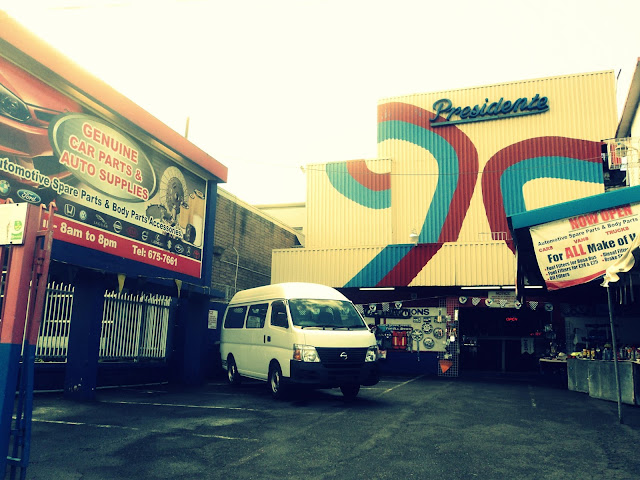 |
| Collage: Traffic by the Grand Bazaar Flyover (top left), a blur of passers by on the Brian Lara Promenade (bottom left), the huge advertising screen on top of KFC near the Brian Lara Promenade (right) |
‘The richly varied places of the world…are rapidly being
obliterated under a meaningless pattern of buildings, monotonous and chaotic’ -
C.W. Moore
Everywhere I go the
same places, the same
faces, the same buildings, the same problems.
Street signs, repetitive designs,
all melding together into one
monochromatic blur.
I feel nothing, toward to city,
No emotion, even less consideration
toward the notion that this is my city.
In and out.
Cars move
in and out and up and down
streets.
People move in and out and up and down streets,
and buildings.
No one looks around, no one to stop
to look and listen,
and FEEL.
So many people, so much diversity
yet…the production and reproduction of
a city consisting of shades of grey,
furthermore dulled
by superficial relationships compounded by inauthentic
places,
a flat, monotonous, commercialized urban space.
 |
| one giant 'suburbia', where everything is the same... |
(i)
The city is not just
buildings and roads. It is not simply physical, material, tangible. Rather the
city is what we FEEL…what we SMELL…what we TASTE…and what we SEE. The city is a
mixture of emotion…love, anger, sadness, happiness, frustration, amazement. The
city is a beautiful and magical place to some, while to others it’s a dark,
lonely pit. Why is this? How can the same city be represented with such
opposite features? The role of our senses, our bodies, our perceptions should
not be taken for granted as we deconstruct that which is urban. So far in my
previous blog entries I have looked at the city as an accumulation of physical
features. This entry I will attempt to take it a bit further, to dive into the
realm of an aspect of cities that I feel is not accounted for in the physical
planning of urban areas…Emotional relationships between person and place…let
see if you all can keep up with my psychological mumbo-jumbo…


Really I’d like to jump
right into some academic analysis on everyday life in cities, and what it means
to value landscapes….but I was particularly glad when I read this chapter, as
doing a double major in Geography and Psychology; I finally got a change to say
to all those people shooting me judgmental looks when they hear of my degree
choice, “See!! They do go together!!” (In this one tiny chapter of this one
random book haha).
(ii)
That being said, the
focus of this week’s entry is a picture collage displayed above made up of
fragments of photographs which I hope will portray the idea of “Experiencing
the city” which Hall and Barrett in their book ‘Urban Geography’ talk about in
Ch. 10.
They cite Edward Relph in this
chapter, and his critique of urban landscapes, which I found quite exhilarating.
Relph argues that ‘the modern urban world is becoming increasingly characterized
by inauthentic places and superficial relationships between people and place’.
With increasing globalization (note his point of view is strictly
anti-globalization), Relph argues that growing mobility, travel, the
centralization of planning and increasing commercialization of urban landscapes
added to the serial reproduction of architectural designs is contributing
toward the erosion of the deep emotional attachments between people and place.
‘We appear to be forsaking nodal points for a
thinly-spread coast-to-coast continuity of people, food, power, and
entertainment; a universal wasteland … a chromium-plated chaos’- Gordon Cullen
 |
'Media-scapes' : the look of globalization,
a universal wastelend of food, power and entertainment... |
Now on a side note, for those
who have been keeping up to date with my blog entries, the same factors Relph
notes above are some of the things I critiqued (quite harshly at times) in my
previous posts…this got me thinking as to whether I was (maybe a little)
anti-globalization…while this is quite a controversial stance (and I am neither
going to agree nor disagree as to my my affiliation with this point of view) I
feel that we need to start coming to terms with the possibility that the ‘globalization’
we learn about in primary and secondary school isn’t the ‘fairy-land-fantasy’
that it’s made out to be…the fact is not everyone benefits from increased capitalism,
liberalized trade and from my point of view this ‘global village’ everyone
paints in bright, pretty colours is quite frankly a ‘dog-eat-dog’ world,
plagued with inequality, poverty, injustice, abuse, neglect and the list goes
on and on…
 |
Globalization,
a dictatorship if I ever saw one... |
"Capitalism
is a thug's economy, a heartless economy, a base and vile and largely boring
economy. It is the antithesis of human fulfillment and development. It mocks
equity and justice. It enshrines greed…" - Michael Albert
Now, back on track then…in terms of our senses and the
city, not a lot of work has been done within Urban Geography studies on the
role of these senses in understanding the environment. In my opinion (and I say
this with little intention to offend) this lack of academic attention paid to
the role of the senses is due in part to the entire world of achedemia being
obsessed with the idea of quantitative analysis and positivist tendencies. Us,
social sciences try so hard to keep our discipline in the hard-sciences category
that we overlook the very characteristic that makes us ‘social’- people,
emotions, perceptions…irrational, illogical human behavior. Thank the universe
that someone came up with ‘environmental psychology’ and the idea of (god forbid)
cross-disciplinary research which incorporated concepts from behavioral
geography and cognitive psychology.
 |
| The many facets that constitute the Environmental-Behavior, the Space-Body relationship |
Thankfully after all this who-ha, studies
were in fact conducted in an attempt to understand information processing
through our senses as it related to cities. And now we’re back to square one…experiencing
the city
The
point I’m trying to make is that what we feel toward our city, the perception
we have of our urban spaces is a vital part of understanding the ‘urban’.
Vagrants, businessmen, the disabled, minorities and marginalized groups all
have different stories to tell of their experiences within the city. Did the
city embrace them with open arms? Did the city exclude them, damning them to a
cold and splintered reality? What does out city form say about our attitudes
toward people, toward outsiders? I spoke in previous posts about our city not
being reflective of the ‘local’. Does this too not constitute our experience of
the city?
 |
| What is your perception of urban landscape?? |
Lastly, I just want to touch on work done by
Valentine (2001) and a host of researchers before him on the body. This research
moves beyond sensory perception and looks at the ways that bodily abilities
differ between individuals, on a social level. Hall and Barrett describe the body
as ‘providing a bridge between the biological and the social, the private and
the public’. What an amazing dimension of analysis! In studying psychology I’m
so preoccupied with the mind and individual differences in the behaviors of
people, who would have thought to analyze the physical body as a psychological and
geographical dual-process of experience!?
 |
| "the body as the bridge between the biological and the social, the public and the private..." |
In this way, they talk bout they city acting
on the body in social contexts. They mention the pressure on bodies to conform
to the ‘ideal’ or the ‘appropriate’ and the effects of authority, security,
signs, advertisement, and building structures on reinforcing these elements. Imagine
yourself in a city that didn’t cater for your personality, or your physical
characteristics, or your circumstances…imagine your experience of that city…
(iii)
Okay…that was quite
long, I know..so as usually just a few things to look at in case you want to
read up or research some more:
-
Two websites from the University of Central Lancashire’s
website, an interesting read and some of the quotes used came from it:
-
A short video showing people in cities…a lot of visual representations,
what about the other senses? What do you taste, smell, feel?
-
Interesting experience of the city:



























